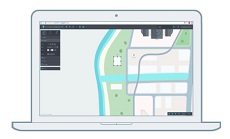
Imagine you are going out of town to negotiate and sign multi-million dollar contract. You are already late for your flight and now you cannot find you way around a large airport. Missing the flight is not an option as you stand to lose multi-million dollar sales opportunity. Wouldn’t it be nice to have a navigation map of the airport on your phone that tells you precisely where the departure gate of your flight is located and the fastest route to get there? Having such a map provided by the airport to the passengers not only helps them navigate and find the gate easily, but it also helps airport owners increase customer satisfaction and improve overall operations.
We have become increasingly reliant on maps to find our way around on the roads. This same navigation technology is now finding its way for indoor use. The indoor maps are being created and provided to customers for number of venues, including airports, malls, large offices, events, trade shows and so on. The ubiquity of smartphones and better indoor navigation technology is making it possible to provide precise location services.
Both customers and businesses benefit from using indoor navigation maps. Customers are able to easily navigate their way around in large, unknown indoor venues. Businesses that provide this service can see improvement in customer satisfaction. It also enables them to provide real-time marketing messages and updates to their customers thus improving the sales opportunity. The data collected through this application also helps building and airport owners better plan their layout for ease of navigation. It also helps them reduce the paper maps leading to reduced cost and waste.
Indoor navigation technology is just starting to catch on with businesses and customers alike. As it advances it will enable number of use cases for businesses to attract more customers and increase sales. For example:
- A business owner can offer a coupon to someone already in the mall and provide navigation map that shows him how to get to their store.
- An airline can provide a map of the airport and direction to the gate when customer receives the boarding pass via text.
- An event organizer can create a temporary map showing all the booths, vendors and amenity areas for their patrons making it easy for them to find their way around in a large venue.
- Hospitals can provide a map to the patients and their families showing different departments and offices that enables them to find their way around in an unknown place.
As you can see the use cases are plentiful and can be tailored for particular location and occasion. If improving customer satisfaction and attracting more customers and sales is your goal then deploying indoor navigation technology can bring you one step closer.






